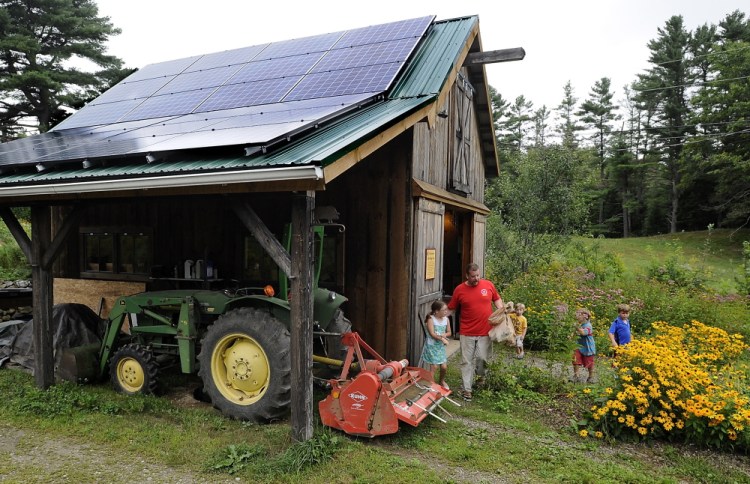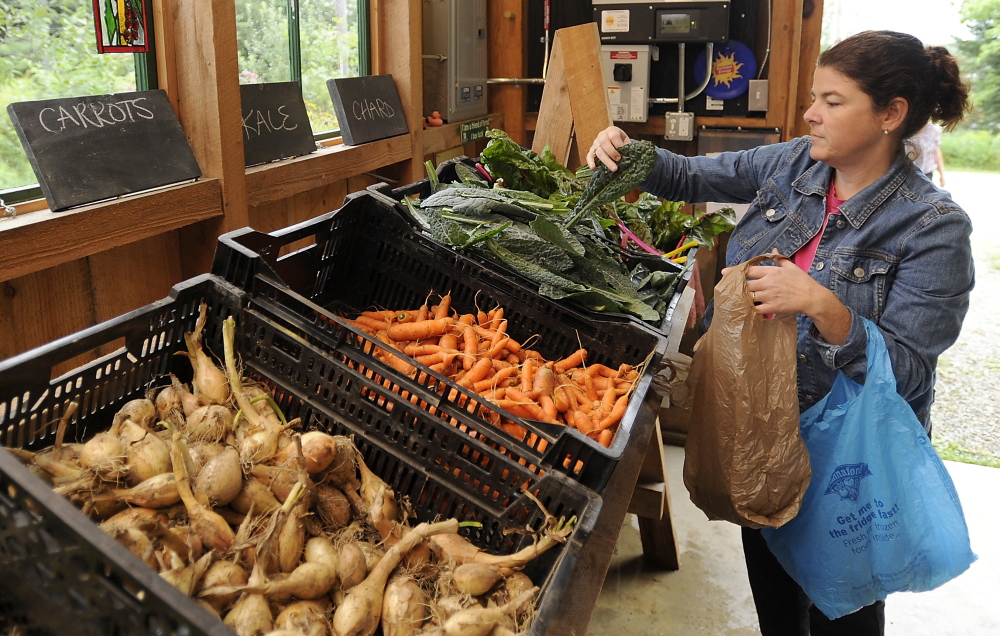LISBON FALLS — The 30 young turkeys foraging in their movable, fenced enclosure at Little Ridge Farm here are bulking up. More than two months old now, they’ll weigh 20 pounds or so by November, and fetch $5 a pound as the organic, free-range star of Thanksgiving supper.
That’s a pricey bird, but these poults spent their first few weeks basking under heat lamps at 95 degrees. The lamps suck up electricity, which contributes to the high cost of that special Thanksgiving turkey.
Next year could be different. Keena Tracy, the farm’s co-owner, just had a 6-kilowatt solar-electric array installed on her barn. It’s sized to generate enough power over a year – roughly 8,000 kilowatt hours – to run heat lamps, a walk-in cooler and assorted fans and lights.
It was a big investment for a small farm, roughly $18,000. But a 30 percent federal tax credit for solar projects and a U.S. Department of Agriculture energy grant cut the net cost to $8,000 and reduced the payback period to six years. After that, Tracy hopes the panels will generate enough power to offset the farm’s total electric bill, roughly $2,400 a year.
“It’s hard to find ways to make an extra $1,000 on the farm,” Tracy said. “So to be able to save $2,400 a year would be great.”
Profit margins are notoriously tight on Maine’s small farms, and Little Ridge Farm is among a growing number of ventures using renewable energy to cut costs and improve the bottom line.
For many small farms, especially organic producers such as Tracy, embracing renewable energy also is part of their general mission statement to operate sustainably, fight climate change and improve their communities.
And while interest in renewables appears to be increasing on the farm, the biggest obstacle to more widespread use of solar, wind and biomass – not surprisingly – is coming up with money to make the initial investment.
Maine has more than 8,000 farms of all sizes and it’s hard to know how many are using renewable energy systems, beyond the familiar wood stove or boiler. The latest USDA agriculture census, from 2012, lists 464 renewable energy systems, led by 358 with solar panels. Most of the rest are small wind turbines. But that’s stale data.
The falling price of solar-electric panels has prompted many new installations to go up across Maine, and the tally probably changes every week.
Take Bar Harbor Community Farm. The six-year-old organic operation grows for families signed up for CSA (community supported agriculture) shares and sells vegetables to restaurants on Mount Desert Island.
It expanded this year and put up a new barn, with a greenhouse alongside to start seedlings.
Many Maine growers want to jump-start seedlings and get their crops to market early. Bar Harbor Community Farm was doing it with stand-alone plastic greenhouses heated by propane. Very expensive, when the seedlings were started in frigid February.
The new greenhouse is attached to the south side of the barn and uses high-efficiency, air-source electric heat pumps for supplemental warmth. Solar-electric panels on the barn will bank power credits in the summer, when electricity production is highest, to temper winter heating bills.
Gary Friedmann, a co-owner of the farm, said he expects the solar-heat pump combo to cut energy costs in half, while doubling the area for seedling production.
“No one is getting rich growing vegetables in Maine,” he said. “But this is going to allow us to make investments in other areas of the farm. It’s going to make the whole operation a little more viable.”
The heating system was installed in May, so Friedmann won’t have figures until this winter. The farm took out a $28,000 loan from a local bank for the barn, and the energy-system cost is being amortized in the loan.
Along with tax credits, the cost of the solar panels is being offset by a $6,868 grant from the USDA’s Rural Energy for America Program. That should help the total investment pay for itself within seven years, Friedmann said.
Money’s just one motive, though. The farm’s stated mission is to provide neighbors with organic vegetables using the highest standards and best practices. That, Friedmann said, includes energy efficiency.
“For us, it’s an important statement that this farm is all about sustainability,” he said.
LIMITED ASSISTANCE
That’s also a general goal of the USDA’s grant program, which most recently awarded a total of $119,700 to 13 rural businesses in Maine. Half went to farmers.
Awards for a new set of projects are expected to be made public later this month.
“We have some really interesting ones, and I’m very pleased,” said Virginia Manuel, USDA Rural Development state director in Maine.
Available funding changes each fiscal year. Maine currently is getting $1.5 million, and there have been more applications than money, according to Manuel. Applicants have to demonstrate energy savings through technology. The grants typically pay for one-quarter of the total cost.
The USDA program is in demand because it’s the only dedicated pot of money in Maine to help farmers with alternative energy projects.
In the last legislative session, a bill that would have established a solar rebate program for farmers through Efficiency Maine made some headway. But under the threat of a veto from Gov. Paul LePage, it was carried over until next year and merged with a broader solar energy study getting underway at the Maine Public Utilities Commission.
The bill’s sponsor, Rep. Tom Saviello, R-Wilton, said he was motivated to help young farmers expanding in western Maine but struggling with high energy costs.
He said there’s not much public awareness of the costs of farming.
“Sadly, too many kids think milk comes from a grocery store,” Saviello said. “They don’t understand how energy-intensive farming is.”
One of this year’s USDA winners is Buck Farms in Mapleton. It received $5,001 to offset the $20,000 cost of a wood pellet boiler to heat a malting facility in a building that previously was used as cold storage for potatoes.
Buck Farms was a conventional Aroostook County potato farm when Jacob Buck’s grandfather started it in 1958, but now the younger generation is trying to diversify with malted barley, hops and animal feed.
The malting facility is tied to the surge in craft-beer production, and the farm is selling to local brewers such as Portland-based Gritty’s and Square Tail Brewing in Amherst, east of Bangor.
“That’s kind of our niche,” Buck said, “so brewers can keep it full-circle and local.”
But the malting process uses a lot of energy, including propane to run a kiln.
Heating oil may be cheap this season, but on average, Buck estimates he could warm the building with locally sourced wood pellets instead of oil and save $1,835 a year. The savings can make a difference between profit and loss, Buck said.
“We’re in a position where we really need to do something or we’re going to lose the farm,” he said. “Every penny counts.”
ENERGY CONNECTS TO COMMUNITY
Wood heat is nothing new on a Maine farm, but Stacy Brenner and her husband, John Bliss, worked hard for years to keep a 30-by-48-foot greenhouse warm using a wood stove. These days, the seedlings at Broadturn Farm in Scarborough are kept cozy with a high-efficiency wood boiler that sends warm water through plastic tubing under heated trays.
The warmed soil has led to better germination rates, and more sleep.
“We don’t have to get up in the middle of the night to feed the wood stove,” Brenner said.
The cost of Broadturn Farm’s boiler was offset with a $8,062 USDA grant. The total system cost roughly $24,000.
The system has worked well and Brenner said she wants to research the potential for solar electric panels on a barn with a south facing roof, and perhaps a small wind turbine on a bluff that seems to have steady breezes.
Broadturn is a community-centered, organic farm on land owned by the Scarborough Land Trust, and Brenner said lowering energy costs helps lower the cost of producing food.
“I don’t think of energy in an isolated way,” she said.
At Little Ridge Farm, Keena Tracy said her costs of hiring labor and buying supplies exceed energy expenses, but she still has to balance the cost of energy with food production.
The Lisbon Falls farm covers 30 acres, with 5 acres in vegetables. Tracy focuses her sales on CSAs, and has 150 families from a 5-mile radius as shareholders.
Because she doesn’t sell at farmers markets, Tracy said she’s not quite as concerned about super-early production. Still, her CSA families don’t want to wait all summer for tomatoes.
Tracy starts seedlings in a 17-by-48-foot greenhouse, a free-standing structure enclosed in two layers of plastic. It’s heated with propane.
“It’s crazy how much of that heat is lost on a cold night,” she said, standing in the greenhouse. “It’s amazing how much propane you can burn.”
Tracy has begun waiting until late March to start the heater. She spent about $700 a year on propane last winter, half of what it would cost if she began seedlings in the first week of March.
Those few weeks make a big difference, she said, in terms of colder nights and less sun.
This winter, when farm chores wind down, Tracy said she might take a cue from Bar Harbor Community Farm and study the viability of warming her greenhouse with renewable energy.
“Everyone loves to eat local,” she said, “but they also want their cucumbers and tomatoes early.”
Copy the Story Link
Send questions/comments to the editors.





Success. Please wait for the page to reload. If the page does not reload within 5 seconds, please refresh the page.
Enter your email and password to access comments.
Hi, to comment on stories you must . This profile is in addition to your subscription and website login.
Already have a commenting profile? .
Invalid username/password.
Please check your email to confirm and complete your registration.
Only subscribers are eligible to post comments. Please subscribe or login first for digital access. Here’s why.
Use the form below to reset your password. When you've submitted your account email, we will send an email with a reset code.